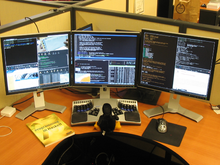
The X Window System is a windowing system for bitmap displays, common on Unix-like operating systems.

An X window manager is a window manager that runs on top of the X Window System, a windowing system mainly used on Unix-like systems.

In computing, a windowing system is a software suite that manages separately different parts of display screens. It is a type of graphical user interface (GUI) which implements the WIMP paradigm for a user interface.

Virtual Network Computing (VNC) is a graphical desktop-sharing system that uses the Remote Frame Buffer protocol (RFB) to remotely control another computer. It transmits the keyboard and mouse input from one computer to another, relaying the graphical-screen updates, over a network.

XQuartz is an open-source version of the X.Org X server, a display server for the X Window System that runs on macOS. It formally replaced Apple's internal X11 app. The name "XQuartz" derives from Quartz, part of the macOS Core Graphics framework, to which XQuartz connects these applications. XQuartz allows cross-platform applications using X11 for the GUI to run on macOS, many of which are not specifically designed for macOS. This includes numerous scientific and academic software projects.

The F Virtual Window Manager (FVWM) is a virtual window manager for the X Window System. Originally a twm derivative, FVWM has evolved into a powerful and highly configurable environment for Unix-like systems.
X.Org Server is the free and open-source implementation of the X Window System (X11) display server stewarded by the X.Org Foundation.
The X video extension, often abbreviated as XVideo or Xv, is a video output mechanism for the X Window System. The protocol was designed by David Carver; the specification for version 2 of the protocol was written in July 1991. It is mainly used today to resize video content in the video controller hardware in order to enlarge a given video or to watch it in full screen mode. Without XVideo, X would have to do this scaling on the main CPU. That requires a considerable amount of processing power, which could slow down or degrade the video stream; video controllers are specifically designed for this kind of computation, so can do it much more cheaply. Similarly, the X video extension can have the video controller perform color space conversions, and change the contrast, brightness, and hue of a displayed video stream.
In computing, the Inter-Client Communication Conventions Manual is a standard protocol for the X Window System. It specifies conventions for clients of a common X server about selections and cut buffers, communication with the window manager and session manager, manipulation of shared resources, and color characterization.

The Direct Rendering Infrastructure (DRI) is the framework comprising the modern Linux graphics stack which allows unprivileged user-space programs to issue commands to graphics hardware without conflicting with other programs. The main use of DRI is to provide hardware acceleration for the Mesa implementation of OpenGL. DRI has also been adapted to provide OpenGL acceleration on a framebuffer console without a display server running.
Workspace is a term used in various branches of engineering and economic development.
In computing, the X Window System is a network-transparent windowing system for bitmap displays. This article details the protocols and technical structure of X11.

In the X Window System, an X display manager is a graphical login manager which starts a login session on an X server from the same or another computer.

The Sun Ray was a stateless thin client computer aimed at corporate environments, originally introduced by Sun Microsystems in September 1999 and discontinued by Oracle Corporation in 2014. It featured a smart card reader and several models featured an integrated flat panel display.

In computing, a virtual desktop is a term used with respect to user interfaces, usually within the WIMP paradigm, to describe ways in which the virtual space of a computer's desktop environment is expanded beyond the physical limits of the screen's display area through the use of software. This compensates limits of the desktop area and is helpful in reducing clutter of running graphical applications.
Multiplicity is a computer program that enables one keyboard and mouse to access two or more client computers from a host computer. It was developed for Stardock as part of their ThinkDesk subscription service, but is available separately.
Xsun is an X Window System (X11) display server implementation included with Solaris, developed by Sun Microsystems. It replaced the older Xnews server, which supported the display of not only X11 applications, but also NeWS and SunView programs. Xsun discontinued support for these legacy environments, and added support for Display PostScript.

In computing, a tiling window manager is a window manager with an organization of the screen into mutually non-overlapping frames, as opposed to the more common approach of coordinate-based stacking of overlapping objects (windows) that tries to fully emulate the desktop metaphor.
A compositing manager, or compositor, is software that provides applications with an off-screen buffer for each window. The compositing manager composites the window buffers into an image representing the screen and writes the result into the display memory. A compositing window manager is a window manager that is also a compositing manager.
Adaptive Internet Protocol (AIP) is a multi-channel protocol that allows an application running on any of multiple platforms to be displayed on any of a wide range of client systems. It supports rich remote display and input services with a number of display options to deliver the presentation of the remote applications onto the local display either as a standalone window, or within a contained remote environment delivered full-screen or in a standalone window. The protocol also supports audio, printing, and other device mapping services.














